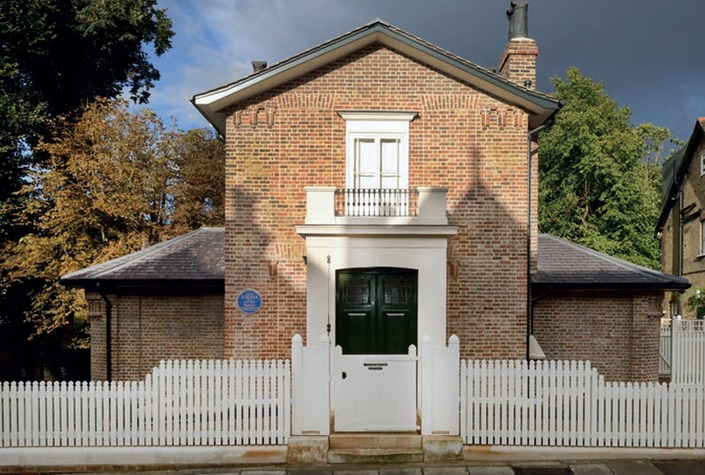Sandycombe Lodge
J.M.W. Turner's House, Sandycombe Lodge
Built by 1814 to his own designs by the great landscape painter J.M.W. Turner (1775-1851), as a retreat from the London art market and a home for his father.
Buying the Land
Turner rented houses at Isleworth and at Hammersmith from 1805 to 1808, using them as bases for painting and sketching trips along the Thames, and indulging his love of fishing. He explored the nearby river landscape, and in 1807 he purchased two plots of land between Sandy Lane (now Sandycoombe Road) and Ferry Lane (now St Margaret’s Road), one of about two acres on which he would build his little lodge, and a smaller meadow where he may have grazed his horse, old ‘Crop Ear’. The two plots appear on the 1818 Enclosure Award, standing alone, with no fear of noisy or nosey neighbours.
Designing the House

Over the next few years, Turner fulfilled his wish to be an architect, making almost 40 sketches for the lodge, scattered through many sketchbooks. Research and the conservation work of 2016/17 revealed that the central block was built first, and the single storey wings were added later. These additions and various elements of decoration, as well as the sophisticated arches of the hall and the elegant top-lit staircase, all suggest that the architect John Soane, Turner’s close friend, advised in their design. Turner’s name first appears in the Rate Books in 1814, and his friend William Havell’s coloured drawing of that date shows the house in its completed state.
Life at Sandycombe Lodge
Turner had a studio, gallery and ‘lodgings’ in Queen Anne Street in Marylebone, but spent much time at Sandycombe. There are accounts of friends and fellow artists coming to visit, often by river, and his sketchbooks are full of images of the river landscape. The Thames also provided recreation and food; any fish that were surplus to the household needs were slipped into the large pond at Sandycombe. The pond was covered with water lilies and surrounded by willows, some grown from a little sliver which Turner cut from a fallen tree in the garden of the long-dead poet Alexander Pope, on Cross Deep.Turner’s father, ‘Old William’, retired from his barber’s trade in Covent Garden, kept house for his son at Sandycombe, as well as looking after the garden.
'Decayed English Artists'
Turner was well aware that his success as an artist was markedly greater than that of many of his fellow painters. In 1818 he acquired a plot of land on Twickenham Common, later adding two adjoining plots, on which he planned to build a ‘College or Charity for decayed English artists (Landscape Painters only) and single men’. These almshouses were to include a gallery. Turner’s relatives contested this part of his will and his charitable wishes were not fulfilled.
Sandycombe after Turner

Turner built Sandycombe during the long Napoleonic wars. After peace finally came in 1815, travel in Europe became possible again and for Turner, hugely desirable. By 1826 the little lodge had become a burden, and Turner sold it to Joseph Todd, owner of the large Twickenham Park estate which lay just across the road to Richmond Bridge. Todd enlarged the house and it was rented for some decades. The house had a number of owners, and after the coming of the railway to the new suburb of St Margaret’s in the 1870s, much of the garden was sold for housing development. During World War ll Sandycombe became a ‘shadow’ factory’ where airmen’s goggles were made, much to the detriment of the fabric of the building. In 1947 the house was bought by Professor Harold Livermore and his wife Ann.
Professor Livermore lived there until his death in 2010, leaving this important building to Turner’s House Trust. His wish was to create a ’monument to Turner in Twickenham’.
Conservation

Turner’s House Trust commissioned conservation architects Butler Hegarty to take on the work of restoring Sandycombe Lodge to Turner’s own design. Their work won a number of prestigious awards.
Sandycombe Lodge opened to the public in 2017 and has hosted several exhibitions of Turner’s paintings.
Visit www.turnershouse.org for details of opening times, information about volunteering, and joining the Friends of Turner’s House. The house is at 40 Sandycoombe Road, Twickenham TW1 2LR.
Further Reading
Catherine Parry-Wingfield J.M.W. Turner, R.A. the artist and his house at Twickenham, Turner’s House Trust 2012, reprinted 2014 & 2018, obtainable from Turner’s House
The conservation of Sandycombe Lodge was the subject of articles in The Turner Society’s Newsletters for Spring and Autumn, 2017, obtainable from The Turner Society www.turnersociety.comTurner Society News, Spring 2017 Sandycombe Lodge, Twickenham.
Part 1 Turner’s House Trust’s Conservation Project Catherine Parry-Wingfield
Part 2 The Architect’s View, Gary Butler, Butler Hegarty Architects
Part 3 Turner’s Developing Architectural Vision, Gary Butler




